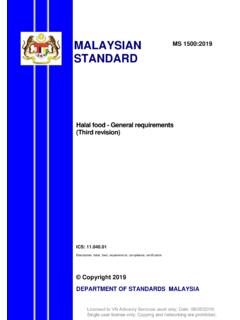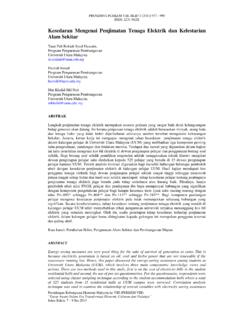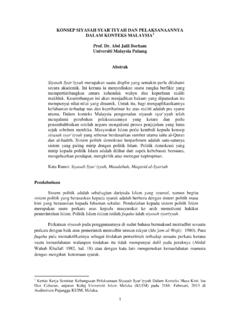Transcription of 1. ICU Protocol Management Cover - MSIC
1 Published by Malaysian Society of Intensive CarePrinted by Malaysian Society of Intensive Care (MSIC)Unit , Level 1, Enterprise 3 BTechnology Park MalaysiaJalan Innovasi 1, Bukit Jalil57000 Kuala Lumpur, Wilayah PersekutuanWebsite: collabration with Ministry of Health MalaysiaCopyright Malaysian Society of Intensive CarePusat kebangsaan ISBN MalaysiaISBN 978-967-11415-4-0 Cover design by Nabil bin AliDisclaimer: The content of this book has been produced in good faith to guide medical practitioners. However practitioners are advised to keep abreast the current evidence-based practices that are constantly evolving and to take into account the local issues and are many aspects in the care and Management of the critically ill patient. As clinicians we need to keep abreast with the most current evidence-based practices to ensure optimal patient care and is an update of the Management Protocol book written in 2012, to facilitate clinicians in the Management of the critically ill.
2 Each Protocol was developed with careful consideration of current evidence as well as the practical application and cost containment within our institutions. The algorithms in the protocols are simple to use and can be easily are great concerns on the rise of multi-drug resistant organisms. We know that critically ill patients are at high risk of acquiring infections. To address this, a Protocol on prevention and control of multi-drug organisms is Protocol materialised due to the many hours of discussion and exchange of opinions. I hope the Protocol will serve as a guide to ICU Management that will enhance the quality of patient like to express my gratitude to the writing committee for their effort in publishing this excellent Management Protocol book. Dr Melor bin Mohd MansorHead of Anaesthetic and Intensive Care ServicesMinistry of Health MalaysiaiWriting CommitteeDr Shanti Rudra Deva(Chairperson and Editor)IntensivistDepartment of Anaesthesia and Intensive CareHospital Kuala Lumpur, Kuala LumpurDr Tai Li Ling(Co-Chairperson)
3 IntensivistDepartment of Anaesthesia and Intensive CareHospital Kuala Lumpur, Kuala LumpurDr Azmin Huda Abdul RahimIntensivistDepartment of Anaesthesia and Intensive CareHospital Sultan Ismail, Johor Bahru, JohorDr Foong Kit WengIntensivistDepartment of Anaesthesia and Intensive CareHospital Raja Permaisuri Bainun, Ipoh, PerakDr Ismail Tan Mohd Ali TanIntensivistDepartment of Anaesthesia and Intensive CareHospital Kuala Lumpur, Kuala LumpurDr Khoo Tien MengIntensivistDepartment of Anaesthesia and Intensive CareHospital Queen Elizabeth 1, Kota Kinabalu, SabahDr Lee See PhengIntensivistDepartment of Anaesthesia and Intensive CareHospital Tengku Ampuan Rahimah, Klang, SelangoriiiiiWriting CommitteeDato Dr Lim Chew HarIntensivistDepartment of Anaesthesia and Intensive CareHospital Pulau Pinang, Pulau PinangDr Mahazir bin KassimIntensivistDepartment of Anaesthesia and Intensive CareHospital Sultanah Aminah, Johor Bahru, JohorDr Mohd Ridhwan Mohd NoorIntensivistDepartment of Anaesthesia and Intensive CareHospital Sultanah Nur Zahirah, Kuala Terengganu, TerengganuDr Muhammad Zihni AbdullahIntensivistDepartment of Anaesthesia and Intensive CareHospital Tengku Ampuan Afzan, Kuantan, PahangDr Nahla Irtiza IsmailIntensivistDepartment of Anaesthesia and Intensive CareHospital Melaka, MelakaDr Noor Airini IbrahimSenior Lecturer and IntensivistFaculty of Medicine and Health SciencesUniversiti Putra malaysia , Serdang, SelangorDr Wan Daud bin Wan KadirIntensivistDepartment of Anaesthesia and Intensive CareHospital Umum Sarawak, Kuching, SarawakTable of ContentsContents PageForeword iWriting Committee iiAdmission, Discharge and Triage 1 Vasoactive Agents in Acute Circulatory Failure 6 Severe Hypoxaemic Respiratory Failure 14 Weaning from Mechanical Ventilation 21 Pain.
4 Sedation and Delirium 29 Nutritional Therapy 39 Early Mobilisation 47 Stress Ulcer Prophylaxis 54 Venous Thromboprophylaxis 57 Prevention and Control of Multi-Drug Resistant Organisms 62 Withholding and Withdrawing Life-Sustaining Treatment 67 Invasive Mechanical Ventilation in Non-Critical Care Areas 74iv1 Admission, Discharge and TriageIntroductionAppropriate utilisation of ICU bed is essential as intensive care resources are limited and expensive. Demand for intensive care will continue to exceed supply, hence clear and rationale decision-making regarding admission and discharge is The decision to admit a patient to ICU should be based on the concept of potential Critically ill patients with a reversible medical condition, having a reasonable prospect of meaningful recovery should be A combination of criteria should be used to determine ICU admission or ICU triaging is necessary to ensure optimal and equitable use of limited intensive care policy1.
5 It is the responsibility of the patient s attending clinician to request for ICU It is the responsibility of the ICU specialist to decide on admission based on his/her clinical judgement guided by the admission criteria. 3. The decision to admit or deny admission shall not be made at the level of a medical Admission from the Emergency and Trauma Department or from another hospital shall have a primary Admission from other hospitals shall be discussed with the ICU specialist prior to It is the responsibility of the primary team to continue resuscitation of patients while awaiting ICU admission. 27. Patients in ICU remain under the responsibility of the primary unit. Transfer of care to a different unit shall be arranged by the primary Family shall be informed of patient s admission to ICU as soon as possible, with further updates when admission criteriaTo optimise ICU resources and improve outcomes, ICU admissions should be guided on the basis of a combination of factors: a.
6 Prioritisation according to the patient s severity of illness b. Specific patient needs such as life-supportive therapies c. Diagnosis d. Prognosis e. Potential benefit from interventions f. Objective parameters at the time of referral g. Available clinical expertise h. Bed availabilityICU admission based on priorityIn evaluating the appropriateness of ICU admission, the priority should be based on the needs of the patient and the likelihood of benefitting from admission. This prioritisation defines those who will benefit most from ICU (Priority 1) to those who will not benefit at all (Priority 3).1. Priority 1 a. Critically ill, unstable b. Require life support for organ failure, intensive monitoring and therapies that cannot be provided elsewhere. This includes invasive ventilation, renal replacement therapy, invasive haemodynamic monitoring and other interventions c.
7 Do not have limitations of treatment d. High likelihood of benefit2. Priority 2 Priority 2A a. Acutely ill, relatively stable b. Requires intensive monitoring and/or therapies for organ dysfunction, that can be managed in an intermediate care facility (high dependency unit or post anaesthetic care unit)3 c. Admit to ICU, if early Management fails to prevent deterioration or there is no intermediate care facility in the hospital d. Examples include: i. post-operative patients who require close monitoring ii. respiratory insufficiency on intermittent non-invasive ventilation Priority 2B a. Critically ill, unstable b. Require life support for organ failure c. With significantly lower probability of recovery because of advanced underlying disease d. May have specific limitations of care no cardiopulmonary resuscitation e. Lower likelihood of potential benefit f. Examples include: i. metastatic cancer in septic shock secondary to hospital acquired pneumonia but with some limitations of therapy no CPR ii.
8 Decompensated heart failure with deteriorating functional status and multiple hospital admissions3. Priority 3 a. Terminally ill or moribund patients with no possibility of recovery b. Not appropriate for ICU admission c. May benefit from palliative care rather than intensive care d. Examples include: i. severe irreversible brain pathology impairing cognition and consciousness or in a persistent vegetative state ii. metastatic cancer unresponsive to chemotherapy and/or radiotherapy iii. end-stage cardiac, respiratory or liver disease with no options for transplant iv. severe disability with poor quality of life v. advanced disease of a progressive life-limiting condition - motor neuron disease with rapid decline in physical status, - severe Parkinson s disease with reduced independence and needs assistance for activities of daily living vi. poor response to current treatment - bowel leak despite multiple laparotomies, - recurrent soft tissue or musculoskeletal infections despite multiple surgical intervention, - chronic medical conditions that fail to respond to treatment such as SLE or HIV4 vii.
9 End-stage renal disease with no option or refusal for renal replacement therapy viii. those who have explicitly stated their wish not to receive life-support therapyTriageTriage is the process of placing patients at their most appropriate level of care. It is often needed as the number of potential ICU patients exceeds the availability of ICU beds. Appropriate triaging allows effective bed utilisation and resource Management . Factors to consider when triaging include: a. Likelihood of benefit b. Prognosis c. Life expectancy due to disease d. Anticipated quality of lifeDischarge policy1. The decision to discharge a patient shall be made by the ICU Prior to discharge: a. The primary team shall be informed of the Management plan including any limitation of treatment. b. A discharge summary shall be completed. c. Any limitation of treatment shall be clearly documented including why and amongst whom these decisions are made.
10 D. Family shall be informed. e. It is the responsibility of the primary team to receive and review patients promptly in the ward. f. Patients who require a higher level of nursing care may benefit from admission to a step down unit, if discharge criteriaIn order to maximise the efficient use of ICU resources, patients should be assessed continuously to identify those who may no longer need ICU care. This includes patient with: a. Stable physiological status and no longer needing ICU monitoring and treatment. b. Stable haemodynamic parameters on low dose inotropic c. Stable respiratory status with oxygen requirement not more than 60%. d. Neurological stability. e. Tracheostomy, not requiring frequent suctioning. f. Chronic mechanical ventilation ( motor neuron disease, cervical spine injury) and the acute critical problem is resolved. g. Deteriorating or irreversible physiological status where active interventions are no longer beneficial.




